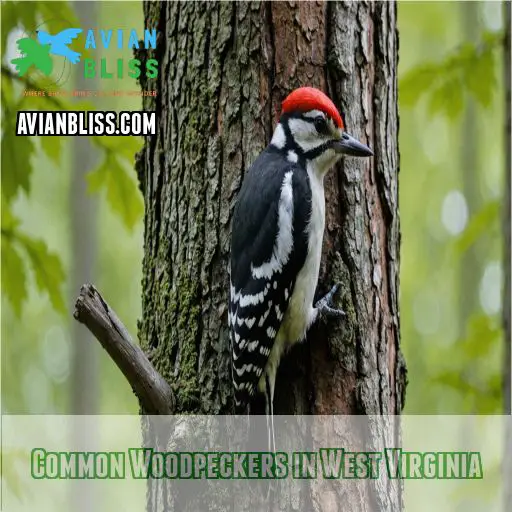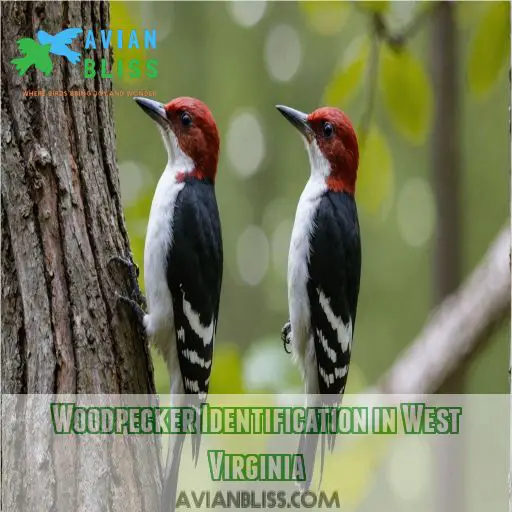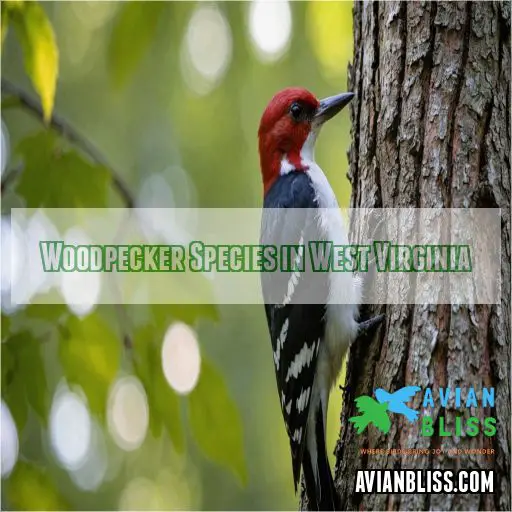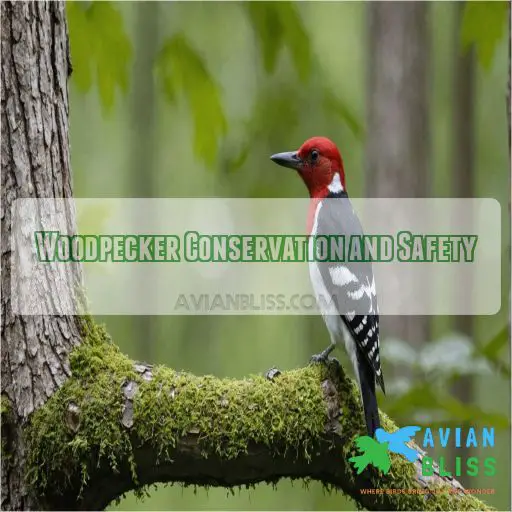This site is supported by our readers. We may earn a commission, at no cost to you, if you purchase through links.
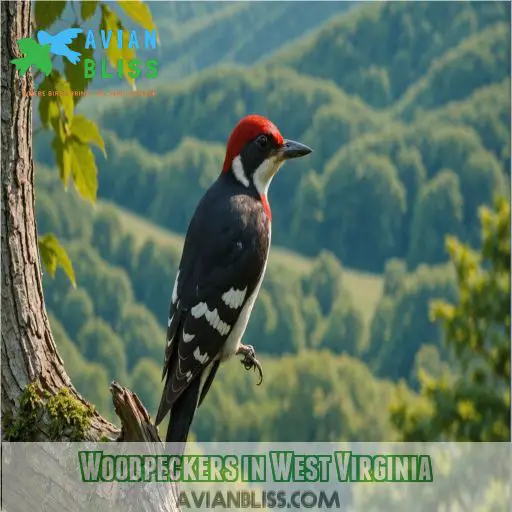
Imagine them as nature’s pest control crew—just without the tiny tool belts!
From Northern Flickers’ "wicka-wicka-wicka" serenade to Pileated Woodpeckers’ impressive crest, these birds add a vibrant touch to any landscape.
Don’t be surprised if you spot one at your feeder—Red-bellied Woodpeckers especially love a tasty snack! Want more woodpecker wisdom? Stick around for some ornithological insights!
Table Of Contents
- Key Takeaways
- Woodpeckers in West Virginia
- Common Woodpeckers in West Virginia
- Woodpecker Identification in West Virginia
- Woodpecker Diet and Foraging Habits
- Woodpeckers and Your Yard
- Woodpecker Species in West Virginia
- Woodpecker Conservation and Safety
- Frequently Asked Questions (FAQs)
- Is it good to have woodpeckers in your yard?
- What is the largest woodpecker in West Virginia?
- Do woodpeckers mean I have termites?
- How do you tell woodpeckers apart?
- How do woodpeckers build their nests in trees?
- What sounds do woodpeckers commonly produce?
- How do woodpeckers contribute to forest ecosystems?
- What threats do woodpeckers face in the wild?
- Which behaviors help woodpeckers find food?
- Conclusion
Key Takeaways
- You’ll quickly see that woodpeckers aren’t just pounding away for fun – they’re nature’s tiny pest control teams. With a knack for snacking on insects, these feathered friends help keep your backyard critter-free without the need for pesky pesticides like Northern Cardinals.
- Keep an eye and an ear out. Whether it’s the Pileated Woodpecker’s impressive size and red crest or the Northern Flicker’s playful "wicka-wicka-wicka" call, West Virginia’s woodpeckers offer a symphony of sights and sounds that’ll make you grab your binoculars and never want to stop birdwatching.
- Got a woodpecker drumming on your house? Don’t panic. These birds often signal hidden insect problems, so consider it a nudge to check for termites. The woodpecker’s keen foraging might just save your home from bigger headaches.
- Become a woodpecker’s best friend by turning your yard into a five-star avian resort. Offer feeders filled with suet and seeds, plant native trees, and let these feathered architects make themselves at home, ensuring you’ve got a bustling little nature haven.
Woodpeckers in West Virginia
West Virginia is home to a diverse array of woodpecker species, each with its own unique features and behaviors.
Birdwatching or a casual backyard observer, learning to identify these feathered friends can add a whole new dimension to your nature experiences.
Overview of Woodpecker Species in West Virginia
Woodpecker diversity in West Virginia is as colorful as a painter’s palette! You’ve got the common hairy and downy woodpeckers, each vying for a spot at the backyard buffet, just like the common resident woodpeckers of Michigan.
Then, there’s the dramatic pileated woodpecker, known for its striking red crest.
Don’t miss the red-bellied woodpecker and the ingenious yellow-bellied sapsucker with their distinct habits and calls.
Woodpecker Distribution and Range in West Virginia
Spotting feathered friends in West Virginia’s vibrant landscapes is a joy. You might wonder where these woodpeckers hang out.
- Deciduous Forests: Look for Downy and hairy woodpeckers here.
- Parks and Backyards: Flickers strut their stuff.
- Old Growth Forests: Pileated Woodpeckers prefer these.
- Birdwatching Hotspots: Climate change impacts bird migration.
Common Woodpeckers in West Virginia
You won’t have to go far to spot some of West Virginia’s most common woodpeckers, like the lively Red-bellied Woodpecker, across your backyard.
Keep an eye open for Hairy Woodpeckers and northern flickers too, and you’ll feel like you’re running a bird bed and breakfast!
Hairy Woodpeckers in West Virginia
You’re in luck if you spot a Hairy Woodpecker in your West Virginia yard! These large, black-and-white birds are common residents, often visiting backyard feeders for suet and seeds. Look for their long, chisel-like beaks and white patches on their backs. Listen for their loud, sharp calls echoing through the trees.
Hairy Woodpecker Traits are easy to identify.
| Hairy Woodpecker Traits | Description |
|---|---|
| Size | Larger than a Downy Woodpecker |
| Beak | Long, chisel-like |
| Plumage | Black and white, with white patches on back |
| Call | Loud, sharp |
| Habitat | Mature forests, suburban areas, parks |
| Diet | Insects, suet, seeds |
Red-bellied Woodpeckers in West Virginia
In West Virginia, the Red-bellied woodpecker adds a splash of color and personality to your backyard bird-watching.
These birds, often seen at feeders, have a misleading name; their bright red heads steal the show.
Their diet includes insects, fruit, and seeds.
You’ll love their quirky calls and playful behavior.
They’re the life of the bird party!
Northern Flickers in West Virginia
Let’s shake things up with the Northern Flicker, a real showstopper in West Virginia.
Known for their stunning yellow-shafted wings, these ant-loving woodpeckers often grace your yard with their presence, darting across lawn and sky.
Listen for the "wicka-wicka-wicka" call, an iconic melody that adds charm to any birdwatcher’s day.
Keep your bird book and camera handy!
Woodpecker Identification in West Virginia
Spotting a woodpecker in West Virginia can feel like finding a hidden gem, but knowing what to look for makes it easy.
You’ll quickly learn to identify these feathered wonders by their size, plumage, unique beaks, and even their quirky calls!
How to Tell Woodpeckers Apart
Moving on from spotting common woodpeckers, telling them apart involves a bit of birdwatching skill.
- Observe their beaks; the Downy Woodpecker’s is petite and the Hairy’s is long.
- Listen for unique calls; the Northern Flicker’s “wicka-wicka-wicka” is quite the jingle!
- Note the habitat; some prefer your backyard while others love the woods.
- Watch for bird dominance at feeders; the Red-bellied’s confidence is unmatched!
Woodpecker Size and Plumage
While telling woodpeckers apart, size and plumage matter.
Size and color serve as nature’s signature.
Spot variations in plumage—look for stripes, spots, and wing patterns.
Use the table below to compare:
| Woodpecker | Wingspan (inches) | Color Patterns |
|---|---|---|
| Downy | 9.8 | Black & White |
| Red-bellied | 17 | Red Cap & Nape |
| Pileated | 29 | Red Crest & Plumage |
Engage with these fantastic birds—nature’s artists with feathers!
Woodpecker Beak Shape and Size
With each woodpecker’s unique beak shape and size, you’ve got a natural toolbox right in your backyard!
Imagine a Downy Woodpecker’s beak as a delicate chisel—small but mighty.
Then there’s the impressive, longer beak of the Hairy Woodpecker, perfect for tougher jobs.
These are nature’s nifty drills, each adapted over time, showing off beak function through jaw-dropping evolution.
Woodpecker Calls and Sounds
Woodpeckers have a diverse vocal repertoire that can help you identify them. Three common sounds are their loud, ringing "wicka-wicka" calls, the rapid drumming on trees used for communication and territory marking, and occasional mimicry of other bird species. Listening closely can reveal the unique voices of these fascinating feathered friends.
- Loud, ringing "wicka-wicka" calls
- Rapid drumming on trees for communication
- Occasional mimicry of other bird species
Woodpecker Diet and Foraging Habits
Ready to learn what fuels the woodpeckers in your West Virginia backyard?
These fascinating birds have varied diets, from ants and other insects to seeds and fruits,
and their foraging habits can turn your backyard into a woodpecker buffet.
What Do Woodpeckers Eat in West Virginia
Woodpeckers in your West Virginia backyard love an insect buffet! From ants to carpenter ants, these birds are nature’s pest control experts.
Keep them happy with suet and sunflower seeds.
Here’s a quick peek:
| Woodpecker Type | Preferred Food | Visit Backyard Feeders |
|---|---|---|
| Downy Woodpecker | Insects, seeds | Yes |
| Hairy Woodpecker | Wood-boring insects | Yes |
| Northern Flicker | Ants, insects | Yes |
| Red-bellied Woodpecker | Seeds, insects | Yes |
Woodpecker Foraging Habits
Exploring the menu options of woodpeckers is like stepping into a buzzing insect bistro.
Their diet mainly includes insect prey found under bark or in trees, which they expertly forage.
Picture them nonchalantly poking around wood, often improvising their edgy foraging techniques.
During winter, though, these feathered gourmets may ramp up their search for alternative edibles.
Woodpeckers and Backyard Bird Feeders
Your backyard bird feeders can be a magnet for curious woodpeckers. These high-energy birds relish suet cakes and black oil sunflower seeds.
To attract them, try:
- Offering a variety of feeder types, like suet baskets and tube feeders.
- Placing feeders near trees and shrubs for easy access.
- Refilling feeders regularly to maintain a steady food source.
- Accepting that woodpeckers may dominate the feeder, bullying other birds away.
Woodpeckers and Insect Control
After enticing woodpeckers with backyard feeders, you’ll find they’re natural born pest controllers, which is great for tree health.
Think of them as the original insect exterminators, feasting on wood-boring bugs and ants.
It’s like having a pest control squad that never takes a day off – all while protecting beneficial insects.
It’s a natural method that keeps tree damage in check without lifting a finger!
Woodpeckers and Your Yard
Having woodpeckers in your yard can be a mixed bag—they’re great for controlling pests but can also cause tree damage with their drumming.
Learn how to attract these fascinating birds and manage their pecking behaviors for a harmonious backyard habitat by understanding their habits.
Is It Good to Have Woodpeckers in Your Yard
You might wonder if having woodpeckers in your yard is more joy or trouble. They provide benefits like pest control and conservation support, while adding a splash of color and charm to your surroundings.
- Benefits of attracting woodpeckers:
- Natural pest control
- Beautiful birdwatching
- Enhances biodiversity
- Promotes woodpecker conservation
- Brings lively sounds to your yard
Woodpeckers and Tree Damage
While woodpeckers play an important role in the ecosystem, their drilling can sometimes damage trees in your yard.
Look for signs like large holes or sap leakage, and act quickly to prevent further harm.
Wrapping affected areas with burlap or applying woodpecker repellent can deter them without harming the birds.
With a little care, you can coexist peacefully.
Attracting Woodpeckers to Your Yard
Inviting woodpeckers to your yard can feel like rolling out the red carpet for nature’s pest controllers.
To make your backyard a woodpecker haven, consider these tips:
- Install woodpecker feeders—fill with suet or peanuts.
- Plant native trees for shelter.
- Make suet recipes, ideal for energy.
- Maintain backyard safety—avoid harmful pesticides.
Keep an eye out!
Woodpeckers and Pest Control
After figuring out how to attract woodpeckers, let’s talk about their knack for natural pest control.
Imagine tiny exterminators in charming feathered costumes! They feast on insects like ants and beetles hiding in the trees.
Aside from some bark-pecking curiosity, woodpecker damage is minimal, making them backyard heroes.
Enjoy fewer pests and a lively birdwatching experience!
Woodpecker Species in West Virginia
If you’re in West Virginia, you’re in luck because there’s a delightful lineup of woodpecker species to watch for like those found in South Dakota.
From the magnificent Pileated Woodpecker with its striking red crest to the unassuming but fascinating Yellow-bellied Sapsucker, you’ll discover a world of feathered fun right in your backyard!
Pileated Woodpeckers in West Virginia
If you’re lucky, you might spot the majestic Pileated Woodpecker in the mature forests of West Virginia.
These large, striking birds with their bold red crests and white stripes are quite a sight to behold.
Listen for their loud, echoing "cuk-cuk-cuk" calls that can carry for miles.
Pileated woodpeckers feast on carpenter ants and other wood-boring insects, helping to control pests in your area.
Red-headed Woodpeckers in West Virginia
Red-headed woodpeckers are a striking sight in West Virginia, even if they’re less common. You might just find them in open woods or around dead trees, acting like they’re auditioning for a movie with their bright red heads.
- Often nests in cavities.
- Known for food storage in trees.
- A black-and-white checkerboard body.
- Shows off an impressive mid-air catch.
Yellow-bellied Sapsuckers in West Virginia
Yellow-bellied Sapsuckers, with their quirky name, add a unique flair to West Virginia’s avian ensemble.
These woodpeckers leave their mark—literally—by drilling sap wells in trees, which may raise eyebrows over potential damage.
But fear not! The sapsucker’s diet and range contribute ecologically, maintaining balance.
Embrace their humor-inducing antics as they play a peak role in the woodpecker family.
Other Woodpecker Species in West Virginia
Exploring woodpecker variations in West Virginia? While the Downy and Hairy woodpeckers enjoy the spotlight, rare sightings such as the Red-headed woodpecker can charm anyone with its fiery crown.
You’ll find these birds across diverse West Virginia habitats.
Their distinctive woodpecker sounds echo through forests, making it easy to forget the potential sapsucker damage they can cause.
Woodpecker Conservation and Safety
While woodpeckers play an important role in controlling termites and other pests, they can sometimes cause damage to homes.
Fortunately, there are effective ways to protect your property and support woodpecker conservation efforts in West Virginia.
Woodpeckers and Termites
Woodpeckers do a little jig when they find termites in your yard. This Woodpecker-termite interaction helps keep those pesky critters at bay. Termites in West Virginia, beware! These birds:
- Peck into wood to snatch termites
- Reduce your need for harsh termite control methods
- Help maintain your yard’s ecosystem naturally
- Offer nature’s pest control team in feathered form
Bravo, woodpeckers!
Woodpeckers and Other Pests
You might think woodpeckers only deal with termites, but they also munch on other pests. It’s like having a feathered pest control squad in your backyard! They help manage insect populations, offering a natural, rhythmic balance to your garden. Keep those bird feeders stocked, and they’ll handle pesky critters.
| Pest | Woodpecker Benefit | Tip |
|---|---|---|
| Termites | Natural control | Attract with suet |
| Ants | Insect reduction | Install feeders |
| Beetles | Garden helper | Fresh water nearby |
| Wasps | Nest management | Plant native shrubs |
| Caterpillars | Ecosystem balance | Avoid pesticides |
How to Protect Your Home From Woodpeckers
Keeping woodpeckers at bay can be like herding cats.
Protect your home by utilizing sound deterrents or installing protective netting.
Adjust bird feeder placement to discourage nesting, and try wrapping tree trunks with burlap for added security.
Should damage occur, it’s important to repair it quickly to prevent further intrusion.
Embrace a harmonious coexistence with nature’s industrious drummers.
Woodpecker Conservation Efforts in West Virginia
While protecting your home is important, we must also consider the conservation of woodpeckers in West Virginia.
These remarkable birds play a key role in forest ecosystems.
Here’s how you can help:
- Support habitat preservation efforts to protect old-growth forests and dead trees
- Participate in citizen science projects to monitor woodpecker populations
- Advocate for policies that address climate change and habitat loss
- Spread awareness about the ecological importance of woodpeckers
Frequently Asked Questions (FAQs)
Is it good to have woodpeckers in your yard?
‘Tis a hoot to have woodpeckers in your yard! These feathered friends’ll keep your trees healthy by snacking on pesky insects.
Just don’t be surprised if they start drumming on your roof – it’s their way of saying "howdy neighbor!
What is the largest woodpecker in West Virginia?
The Pileated Woodpecker is the largest in West Virginia, with a bold red crest and distinctive white stripes.
It’s like the "king of the woods," dominating the forest with its size and loud calls.
Do woodpeckers mean I have termites?
Imagine woodpeckers as nature’s detectives, tapping to reveal hidden secrets.
Hearing them doesn’t guarantee termites, but it’s a sign to inspect your home.
Woodpeckers also hunt other insects, so stay calm and investigate further.
How do you tell woodpeckers apart?
Spot woodpeckers by examining size, bill length, and head markings.
Downy woodpeckers are smaller with shorter bills; flickers have striking yellow underwings.
Don’t forget the pileated’s iconic red crest!
Keep binoculars handy and enjoy birdwatching!
How do woodpeckers build their nests in trees?
Woodpeckers are true masters of their craft, chiseling away at trees like skilled artisans.
With their powerful beaks, they carve out cozy cavities, crafting the perfect abode to call home.
It’s a sight that’ll leave you in awe.
What sounds do woodpeckers commonly produce?
You’ll find woodpeckers producing unique sounds like resonant drumming to establish territories.
Calls like the Pileated’s “cuk-cuk-cuk” and Northern Flicker’s "wicka-wicka-wicka," each patterned to communicate their needs and moods, are unique to each species.
How do woodpeckers contribute to forest ecosystems?
In their daily dance with trees, woodpeckers craft miniature homes in trunks, offering cozy cribs for critters.
Woodpeckers are ecosystem MVPs, keeping forests healthy and balanced like a well-oiled nature machine .
What threats do woodpeckers face in the wild?
Imagine a vibrant forest silenced; habitat loss, climate change, and pesticide use threaten their survival.
Let their drumming be a reminder of nature’s resilience.
Protect these feathered percussionists by conserving forests and avoiding harmful chemicals.
Which behaviors help woodpeckers find food?
Woodpeckers use their sharp beaks to probe tree bark and dig into wood, uncovering insects, larvae, and sap that make up their diverse diet.
Their long, sticky tongues help them extract these tasty morsels from their hiding spots.
Conclusion
Prepare for a wild, woodpecker whirlwind in West Virginia!
With their rhythmic drumming and vibrant plumage, these birds aren’t just eye candy—they’re lively, natural pest controllers right in your yard.
From Pileated powerhouses to the charming Red-bellied Woodpeckers, you’ll find great joy in watching their antics.
By understanding their habits and needs, you can turn your yard into a feathered paradise.
Embrace the diversity and value woodpeckers in West Virginia bring to your outdoor space!

